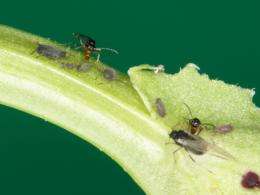Solving an old mystery with wasps

Swiss researchers at ETH Zurich and the University of Zurich have discovered that a single gene in a particular aphid wasp decides whether the insects reproduce sexually or asexually. This is not only of interest for pest control, but could also help answer a central question of evolutionary biology.
Why does sex exist? Even now, evolutionary biologists have not yet found a satisfactory answer to this simple question. Asexual reproduction would really be much more efficient from an “economic” point of view, since in sexual reproduction with separate genders only a certain proportion of the organisms - the females - give birth to progeny. Nonetheless, sexual reproduction has become widely established during the course of evolution. Various theories attempt to explain why this is the case – so far without success. This is because these theories are very difficult to test empirically. In fact, there are animal species that reproduce both sexually and asexually; in these species, however, the sexually produced individuals also differ from those produced asexually in terms of other characteristics, so that an unbiased comparison is virtually impossible.
However, Christoph Vorburger, Swiss National Science Foundation (SNF) Professor of Evolutionary Ecology at the Institute of Integrative Biology of ETH Zurich and the EAWAG (Swiss Federal Institute of Aquatic Science and Technology) in Dubendorf, along with his doctoral student Christoph Sandrock from the University of Zurich, have now discovered that an empirical study of this central question of evolutionary biology might be possible using a particular species of parasitic wasp. During their study, the two researchers examined the aphid wasp Lysiphlebus fabarum, which had long been known to be capable of reproducing in both ways. Vorburger and Sandrock have now shown that there is practically no difference between sexual and asexual individuals in this species of wasp – apart from the fact that they reproduce differently, of course. Thus the genetic differences between individuals are no greater than those which would exist in a population in any case.
Precise agreement with theory
In wasps that reproduce sexually, females originate from fertilised egg cells while males are produced from unfertilised egg cells (haplo-diploidy). In the case of asexual wasps, on the other hand, the females give birth only to daughters, without fertilization. Vorburger and Sandrock wanted to know which genetic factors decide whether a wasp will reproduce sexually or asexually. Astonishingly, it turned out that this fundamental difference is evidently controlled by just a single gene. Using crossbreeding experiments, the two scientists were also able to show that the trait is inherited recessively. In the third generation of their experiment, they found that exactly 12.5 percent of females reproduced asexually – which is precisely the number predicted by Mendel’s laws of inheritance for a recessive trait in haplo-diploids.
Vorburger and Sandrock still do not know which gene determines the mode of reproduction. “We could only demonstrate that the trait behaves like a single genetic factor, and we already know of one microsatellite, i.e. a genetic marker, which is located close to the decisive gene,” explains Vorburger. “We now want to answer this question in a further study”.
A real improvement in pest control?
Vorburger and Sandrock’s discoveries are interesting not only for evolutionary biology but also from the point of view of pest control. Aphid wasps such as L. fabarum are used for biological pest control because they lay their eggs in aphids, thus killing the pests. Since in the case of sexual wasps only half of the individuals contribute effectively towards pest control – namely the females which lay their eggs in the aphids – it might be possible to improve the efficiency of this method by using asexual wasps instead. “However, the increased effectiveness might be merely a short-term success,” says Vorburger, “because asexual reproduction yields only genetically identical lines. The lack of genetic exchange may constrain their ability to adapt to changes in ecological conditions.”. It is precisely this adaptability that many evolutionary biologists believe is ultimately the reason why sexual reproduction has become established in nature – even if, at first sight, it appears less economical.
More information: Sandrock C and Vorburger C, Single-Locus Recessive Inheritance of Asexual Reproduction in a Parasitoid Wasp, Current Biology (2011), doi:10.1016/j.cub.2011.01.070
Provided by ETH Zurich

















